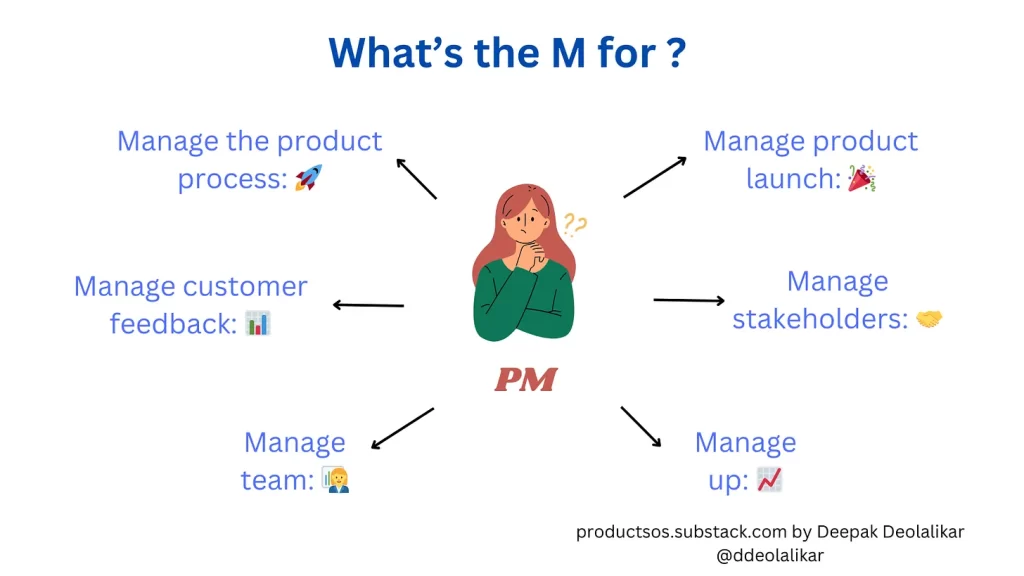Turns out PMs have to manage a lot

If you’ve been keeping up with social media posts from product management experts, you’ve probably noticed a common theme: everyone’s trying to define what product management really is.
With no universally agreed-upon definition of PM, two new trends have emerged. First, there’s the famous talk by Brian Chesky where he discussed ending traditional product management to cheers from the crowd. Second, there’s the increasing use of AI in PM roles, sparking debates on how the job will change, if not disappear entirely.
In my view, PMs will actually become more important, especially those focused on revenue growth for their companies.
While a lot is said about the “P” in product management – product thinking, product sense, prioritization, and product execution – what about the “M”?
Of course, “M” stands for management.
The term “manager” in PM or management often creates confusion. It implies that you’re managing a team of PMs, much like a finance or sales manager. But in reality, management is about the product, not the people. Whether you’re a team leader or an individual contributor, you still have a lot to manage.
So, what do PMs manage? It turns out, a lot.

1. Manage the product process
Foremost, the PM has to manage the product process itself. This of course is the primary job of a product manager. Lead the journey from idea to execution, steering the product towards success by setting vision, prioritizing features, and ensuring timely delivery.
Facilitate vision, goals, strategy: A product manager ensures that the team understands the overarching vision and goals of the product. For instance, Steve Jobs famously outlined Apple’s vision for the iPhone as a revolutionary device that combines a phone, iPod, and internet communicator.
Prioritize and evangelize roadmap: PMs like Julie Zhuo at Facebook prioritize features based on user needs and market trends. They then evangelize this roadmap to stakeholders, gaining buy-in for the proposed direction.
Timely delivery: Amazon’s product managers, for example, meticulously manage delivery timelines, ensuring that products launch according to market demands, such as the release of the Kindle just before the holiday season.
Quality: Google’s PMs, exemplified by Sundar Pichai, emphasize quality by conducting rigorous testing and iterating on products like Gmail to ensure a seamless user experience.
Market and competitive analysis: At Spotify, product managers like Gustav Söderström continuously analyze market trends and competitor strategies to inform product decisions, such as integrating podcasts to compete with rival streaming platforms.
2. Manage product launch
Taking the product from the shop floor all the way into the customers hand, requires an orchestration of a number of activities and can involve all parts of your company. Direct a seamless transition from development to market, aligning teams, timelines, and messaging for a successful product launch.
– Align cross functional activities: Tesla’s PMs coordinate with engineering, manufacturing, and marketing teams to ensure a smooth product launch, as seen with the release of their Model 3 electric car.
– Adhere to timelines: Apple’s product launches, such as the annual iPhone releases, are meticulously planned and executed to meet strict deadlines set by the company’s leadership.
– Ensure consistent messaging and communication: Microsoft’s PMs, exemplified by Panos Panay, maintain consistent messaging across various channels during product launches, ensuring a cohesive narrative for products like the Surface lineup.
– Ensure readiness across the company: Airbnb’s product managers ensure that all departments, from customer support to legal, are prepared for the launch of new features, guaranteeing a seamless user experience.
3. Manage customer feedback
It’s not enough to deliver the product to the customer. You have to make sure they get value and fix problems in future iterations. Foster a feedback loop with customers, leveraging insights to refine the product, enhance user experience, and drive continuous improvement.
– Create a system for gathering feedback: Netflix’s PMs implement robust feedback mechanisms, including user surveys and data analytics, to understand user preferences and pain points, shaping product enhancements like personalized recommendations. In B2B, you will get input from a variety of sources and it would be best to have a system in place to manage that barrage of feedback. You can read more on managing customer feedback in a prior post.
– Monitor usage: Implement advanced analytics tools and user tracking mechanisms to continuously monitor user interactions, feature adoption rates, and user journey analytics. For instance, streaming platforms like Netflix utilize sophisticated algorithms and data analytics to track user viewing habits, engagement patterns, and content preferences, allowing them to personalize recommendations, optimize user interfaces, and drive user retention strategies based on real-time usage data.
– Act on customer feedback: Slack’s PMs swiftly address user feedback by prioritizing feature updates and bug fixes, fostering a loyal user base through continuous improvement. The feedback is valuable not just for product development but also for improving your product messaging and positioning. You can read more on how to act on customer feedback in this article.
4. Manage stakeholders
In B2B, a PM will need to work with all kinds of stakeholders. Build strong partnerships across the organization, aligning interests, building consensus, and fostering collaboration to propel the product forward.
– Align expectations across internal stakeholders: Salesforce’s PMs ensure alignment between sales, marketing, and product teams to deliver cohesive solutions tailored to customer needs, enhancing the company’s reputation for customer-centricity.
– Create momentum and energy: IBM’s PMs inspire cross-functional teams by articulating a compelling vision for products like Watson, fostering innovation and collaboration.
– Foster a collaborative environment: At Adobe, PMs cultivate a culture of openness and trust among stakeholders, encouraging diverse perspectives and driving creativity in product development, as evidenced by the success of Adobe Creative Cloud.
5. Manage team
It takes a village to launch products. Your developers, QA, designers, architects are all contributors to your product. Inspire and empower a diverse team of professionals, aligning goals, nurturing productivity, and fostering a culture of innovation and success.
– Motivate them for success: At Google, PMs like Hiroshi Lockheimer motivate their teams by setting ambitious but achievable goals, fostering a culture of innovation and excellence in products like Android.
– Ensure goals are aligned: Airbnb’s PMs align team objectives with company goals, ensuring that product development efforts contribute to the company’s overall mission of creating belonging anywhere.
– Manage team productivity: Facebook’s PMs implement agile methodologies and project management tools to optimize team productivity, resulting in rapid iterations and feature releases across products like Instagram.
6. Manage up
Whatever level you are in the product team, effectively communicate with superiors and executives, aligning visions, providing insights, and securing support to drive the product’s growth and success.
– Manage executive expectations: At Amazon, PMs manage up by providing regular updates to executives, ensuring alignment between product strategy and corporate objectives, as demonstrated by the success of Amazon Web Services.
– Provide accurate and frequent status: Microsoft’s PMs, under the leadership of Satya Nadella, maintain transparent communication with senior management, providing timely status reports and insights to inform strategic decisions.
– Share vision and plans for product growth: Uber’s PMs articulate a clear vision for product expansion to senior leadership, driving initiatives like Uber Eats’ international expansion and diversification into new markets.
– Justify and ask for resources: At Apple, PMs like Craig Federighi advocate for resources to support product development efforts, presenting compelling business cases for investments in areas like augmented reality technology, as showcased in products like ARKit.
In conclusion, getting the management part of product management right is key for product success. By handling the product process, launches, customer feedback, stakeholders, team management, and communication well, product managers can lead their teams effectively. This helps ensure that products meet customer needs, leading to long-term growth and success for their companies.

